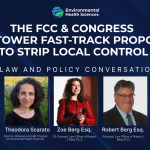
A wide-ranging, ongoing investigation of PFAS in everyday products has uncovered evidence of the toxics in our clothes, food, and makeup—including in many so-called “green” and “organic” brands.
While many are aware of PFAS pollution in water, the testing finds that we’re also exposed by the things we wear or eat. The testing highlights the dangerous unknowns in many U.S. supply chains, as many brands are not intentionally adding PFAS, short for per- and polyfluoroalkyl substances, which contribute to cancer, reproductive and immune systems damages, elevated cholesterol, and other health issues.
The collaboration between EHN.org and wellness community Mamavation looked for fluorine, an indicator of PFAS, and found contamination in products from popular brands like Lululemon, Old Navy, and Burt’s Bees.
It’s not all bad news: many products tested clean. In our guide below you can quickly find PFAS-free products and those that were contaminated. We’ve also armed manufacturers with this information so they can clean up their production from these insidious, harmful chemicals.
Over the next few months we will report on this testing, and give readers the tools to make more informed decisions about products they buy.
Here are the stories:
Part 1: PFAS in sports wear
Coming soon:
Part 2: PFAS in food
Part 3: PFAS in personal care products and makeup
What we’ve found
- In athletic clothing—such as leggings and sports bras— evidence of PFAS contamination, including in brands that had vowed to stop intentionally adding these compounds to their products. And period underwear had high fluorine levels even for companies that have claimed their products were PFAS-free.
- In food—such as spaghetti sauce, peanut butter, and baby food—evidence of PFAS contamination, even in organic and natural brands.
- In personal care products, evidence of PFAS contamination in “PFAS-free” green beauty brands and retailers, highlighting the uphill battle for small manufacturers trying to do the right thing and the need for transparency in supply chains.
What needs to happen
- We are notifying and working with companies to help identify where this pollution is coming from and how it can end.
- We are reaching out to policymakers interested in consumer product safety to alert them to unknown PFAS contamination.
- Share these stories with your friends and family to find products free from harmful chemicals.
- Learn about PFAS dangers and how to avoid them with our helpful guide: What are PFAS?
- Follow the conversation on Twitter at #StopPFAS.
- Have a product or brand you’d like to see tested? Contact us at feedback@ehn.org
Read the stories
This is an ongoing story. There is more testing in the works and we will continue to investigate PFAS in products.
Below are stories we’ve published, and we will update this page as more testing is complete.
First-of-its kind testing points to dangers and unknowns of PFAS in clothing

Experts and advocates say the new testing points to the need for more rigorous regulation.
Banner photo credit (left to right): Brian Brodeur/flickr; Nathan Rupert/flickr; Carlos Martinez/Unsplash




